|
|
|
|
 |
Old Time Radio - Pearl Harbor Attack Announcement Now Playing
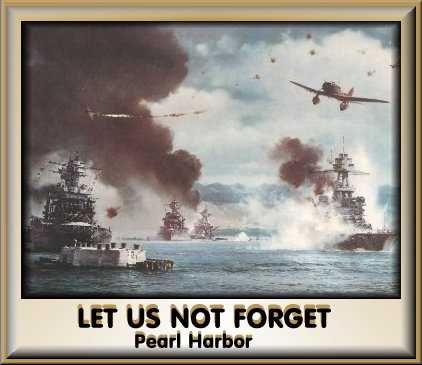
Full
Pearl Harbor Casualty List
December
7, 1941
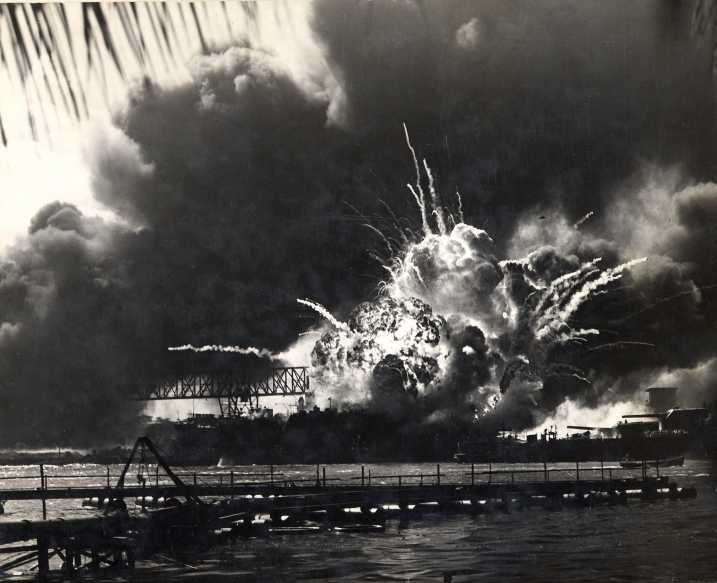
Pearl
Harbor under Attack
Sunday, December 7, 1941
the Japanese launched a surprise attack against
the U.S. Forces stationed at
Pearl Harbor, Hawaii.
By planning his attack on a Sunday, the Japanese
commander Admiral Nagumo, hoped to catch the entire fleet in port.
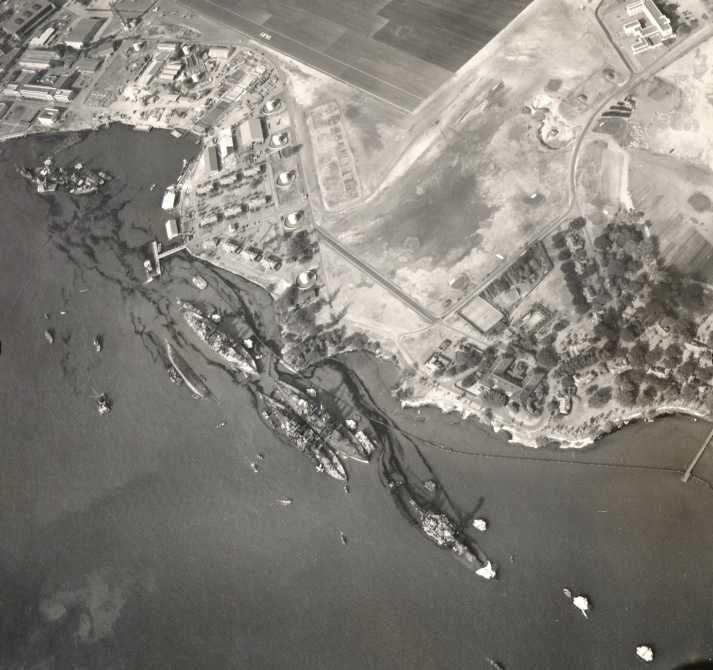
As luck would have it, the Aircraft Carriers
and one of the Battleships were not in port. (The USS Enterprise was returning
from Wake Island, where it had just delivered
some aircraft. The USS Lexington was ferrying aircraft to Midway, and the
USS Saratoga and
USS Colorado were undergoing repairs in the United
States.)
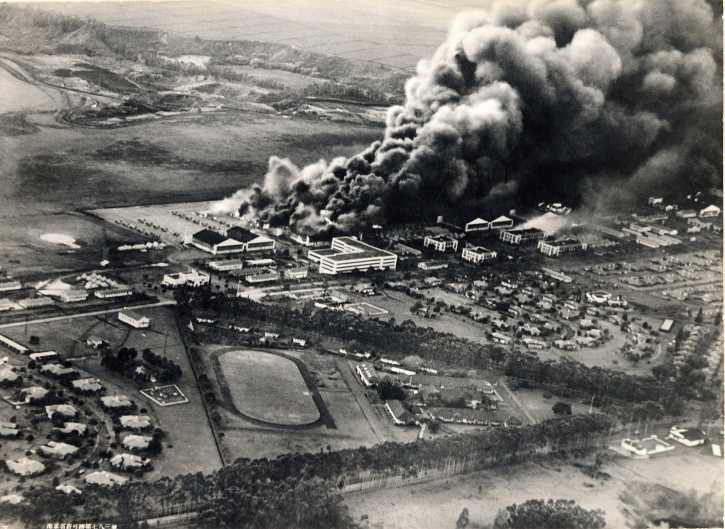
In spite of the latest intelligence reports about
the missing aircraft carriers (his most important targets), Admiral Nagumo
decided
to continue the attack with his force of six
carriers and 423 aircraft. At a range of 230 miles north of Oahu,
he launched the first wave
of a two-wave attack. Beginning at 0600 hours
his first wave consisted of 183 fighters and torpedo bombers which
struck at the
fleet in Pearl Harbor and the airfields in Hickam,
Kaneohe and Ewa.
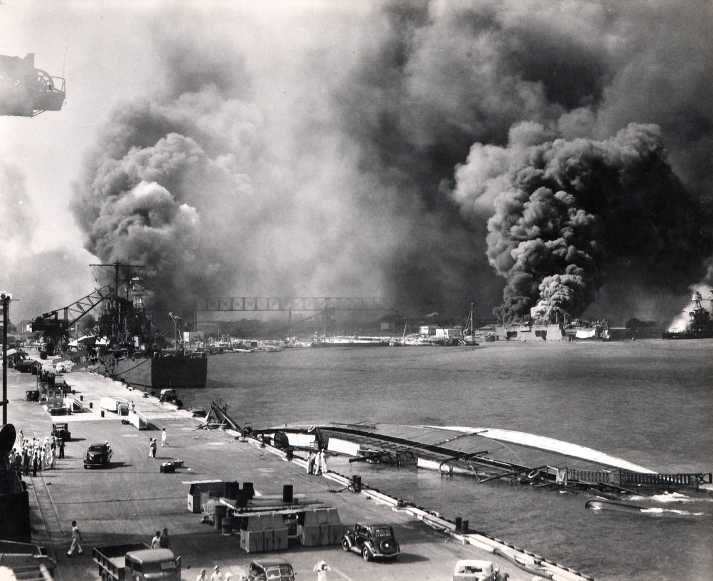
The second strike, launched at 0715 hours, consisted
of 167 aircraft,
which again struck at the same targets.
At 0753 hours the first wave consisting of 40 Nakajima B5N2 "Kate"
torpedo
bombers, 51 Aichi D3A1 "Val" dive bombers, 50
high
altitude bombers and 43 Zeros struck airfields
and Pearl Harbor. Within the next hour, the second
wave arrived and continued the attack.
When it was over, the U.S. losses were:
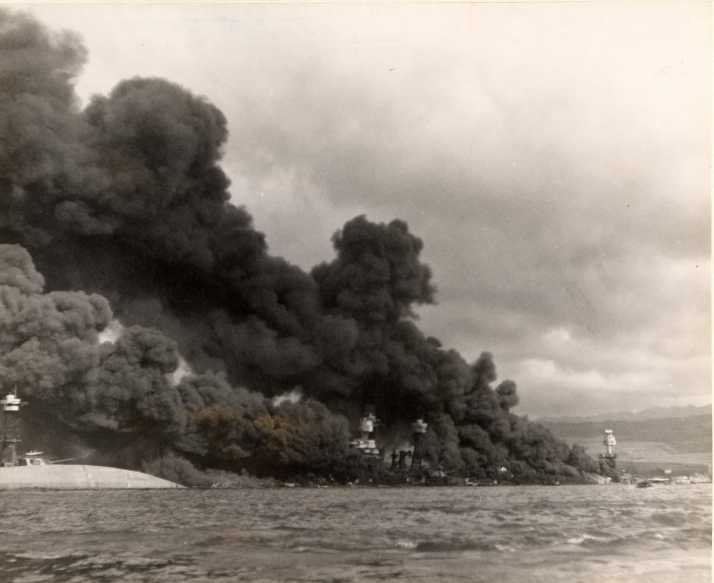
Casualties:
USA: 218 KIA, 364 WIA.
USN: 2,008 KIA, 710 WIA.
USMC: 109 KIA, 69 WIA.
Civilians: 68 KIA, 35 WIA.
TOTAL: 2,403 KIA, 1,178 WIA.
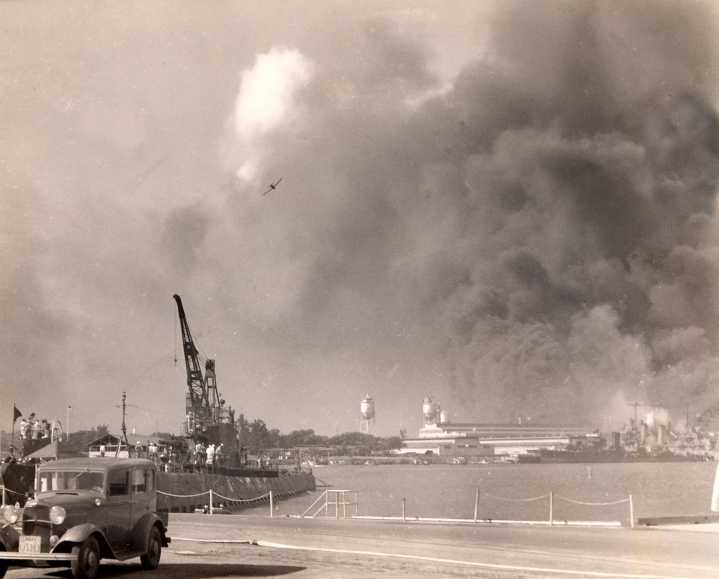
Battleships:
USS Arizona (BB-39) - total
loss when a bomb hit her magazine.
USS Oklahoma (BB-37) - Total
loss when she capsized and sunk in the harbor.
USS California (BB-44) - Sunk
at her berth. Later raised and repaired.
USS West Virginia (BB-48)
- Sunk at her berth. Later raised and repaired.
USS Nevada - (BB-36) Beached
to prevent sinking. Later repaired.
USS Pennsylvania (BB-38) -
Light damage.
USS Maryland (BB-46) - Light
damage.
USS Tennessee (BB-43) Light
damage.
USS Utah (AG-16) - (former
battleship used as a target) - Sunk.
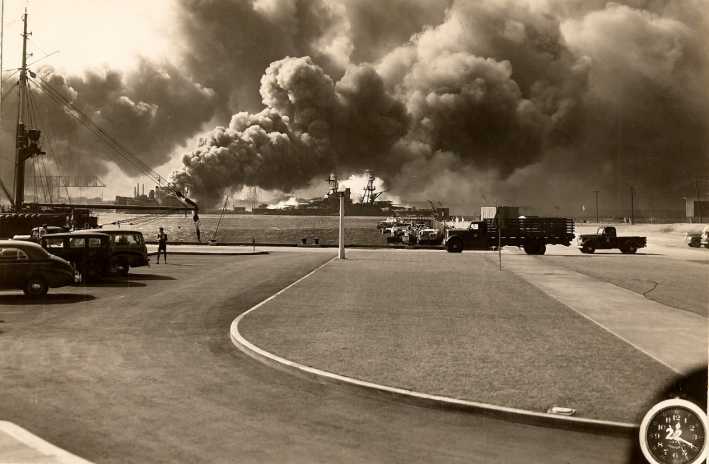
Cruisers:
USS New Orleans (CA-32) -
Light Damage..
USS San Francisco (CA38) -
Light Damage.
USS Detroit (CL-8) - Light
Damage.
USS Raleigh (CL-7) - Heavily
damaged but repaired.
USS Helena (CL-50) - Light
Damage.
USS Honolulu (CL-48) - Light
Damage.
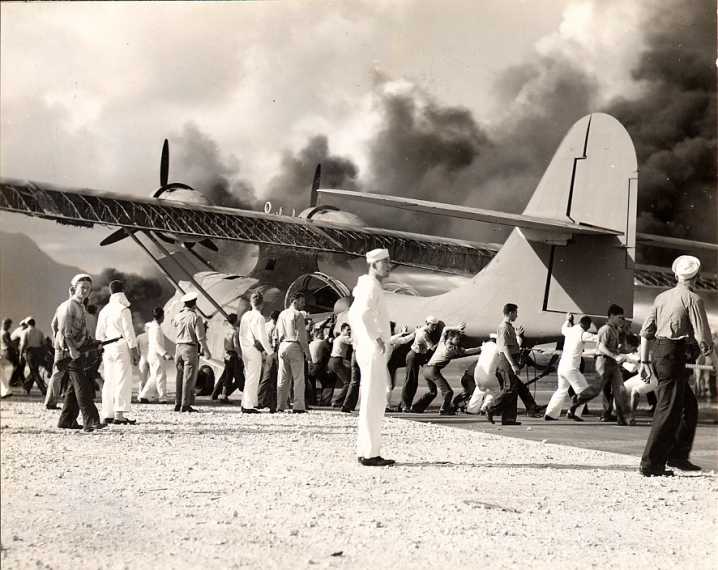
Destroyers:
USS Downes (DD-375) - Destroyed.
Parts salvaged.
USS Cassin - (DD-372) Destroyed.
Parts salvaged.
USS Shaw (DD-373) - Very heavy
damage.
USS Helm (DD-388) - Light
Damage.
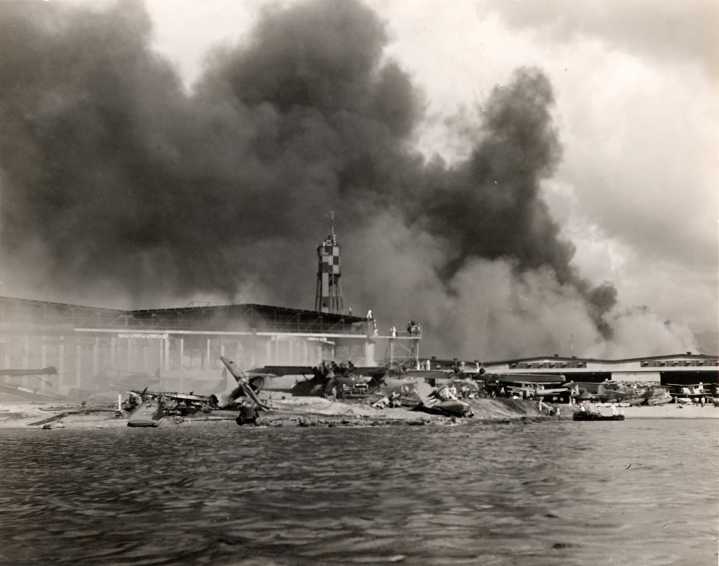
Minelayer:
USS Ogala (CM-4) - Sunk but
later raised and repaired.
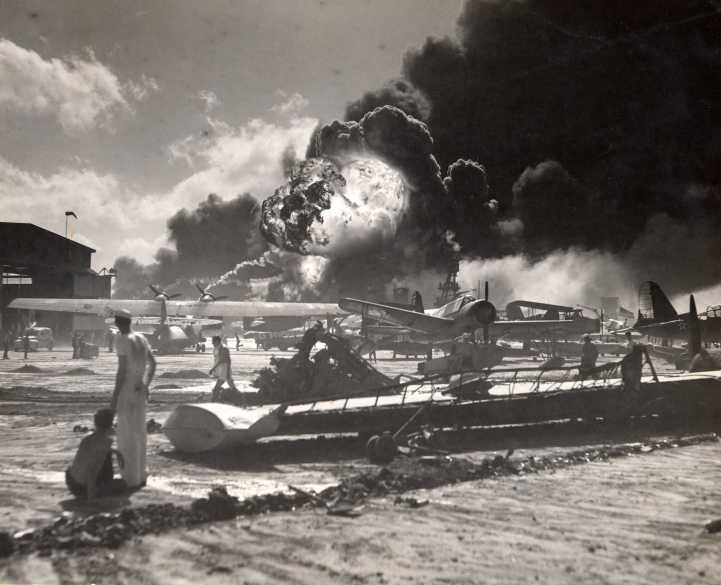
Seaplane Tender:
USS Curtiss (AV-4) - Severely
damaged but later repaired.
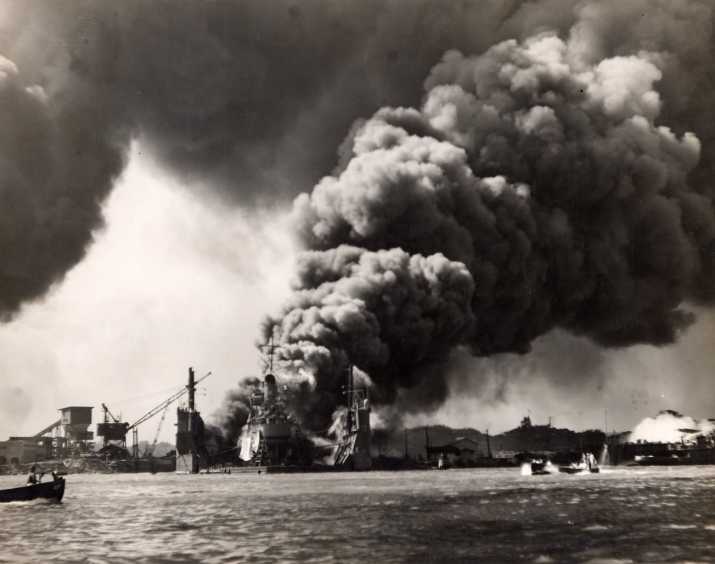
Repair Ship:
USS Vestal (AR-4) - Severely
damaged but later repaired.
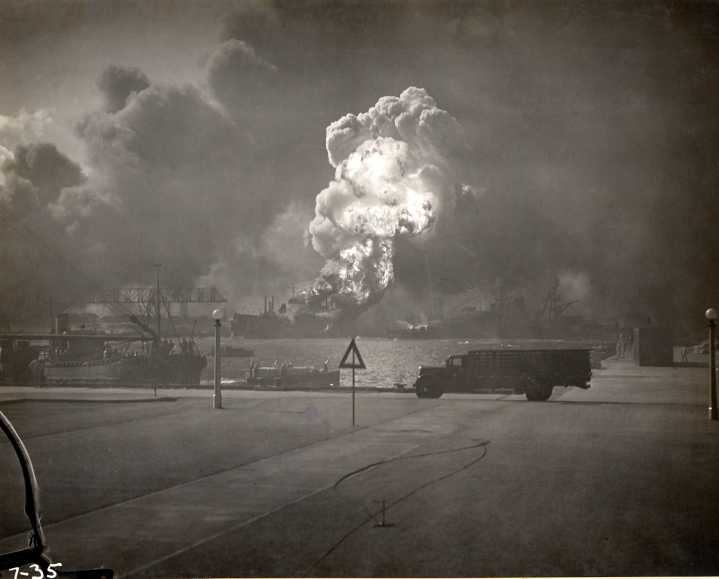
Harbor Tug:
USS Sotoyomo (YT-9) - Sunk
but later raised and repaired.
Aircraft:
188 Aircraft destroyed (92
USN and 92 U.S. Army Air Corps.)
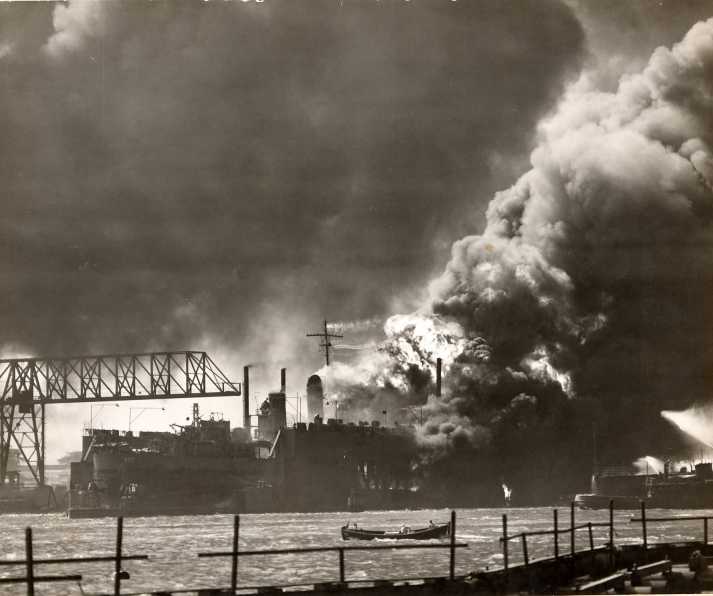
0342 hours The minesweeper Condor is on
patrol less than two miles (3.2 kilometers) off the entrance to Pearl Harbor.
The officer of the deck sees something "about
fifty yards [45 meters] ahead off the port bow."
He asks a sailor what he makes of the object.
"That's a periscope, sir," the sailor replies.
"And there aren't supposed to be any subs in
the area."
The Condor sends a blinker-light message to the destroyer Ward: "Sighted submerged submarine on westerly course, speed 9 knots."
0610 hours Already in flight, Comdr.
Mitsuo Fuchida, who will lead the Japanese air attack on Pearl Harbor,
sees
the Japanese aircraft carriers rocking on a choppy
sea. As the carriers pitch and roll, waves crash across on the flight decks.
Crewmen cling to the aircraft to keep them from
going over the side.
The carriers turn into the wind, and the first
wave of planes—183 fighters, bombers, and torpedo planes—roar into the
sky.
Pilots reconfirm their navigation by using a
Honolulu radio station's music as a guiding beam.
0645 hours The U.S. destroyer Ward,
which had not been able to find the midget submarine reported by the minesweeper
Condor,
moves in for the kill. The Ward's captain, Lt.
William W. Outerbridge, has been in command for only two days. He orders
men
to commence firing. The first shot misses. The
second strikes the submarine at the waterline.
The submarine heels over and appears "to slow
and sink.
" The Ward assures the sinking by dropping "a
full pattern of depth charges."
0653 hours From the Ward to the 14th
Naval Headquarters, at Pearl Harbor Naval Station: "We have dropped depth
charges
upon sub operating in defensive sea area." Then,
almost immediately, a second, more detailed message: "We have attacked,
fired upon,
and dropped depth charges upon submarine operating
in defensive sea area."
The Ward's captain believes that the message will
show superiors that the destroyer had not just
responded to a submarine sighting but actually
had "shot at something."
0702 hours The Army's Opana Mobile
Radar Station is one of six radar stations on Oahu. Radar is a
new defense tool in Hawaii; the system has been
in operation for less than a month.
One of the two privates on duty looks at the radar
oscilloscope and can't believe his eyes. He asks his buddy to take a look—
and he confirms the sighting: 50 or more aircraft
on a bearing for Oahu.
The privates call the Fort Shafter information
center, the hub of the radar network.
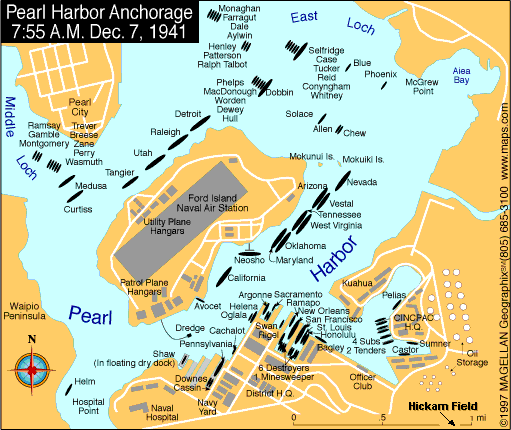
0715 hours The Ward had sent out
its message—that it had attacked an unidentified sub—in code. At headquarters,
code clerks decode the message, then routinely
put it in "paraphrase" so there will not be an exact paper copy that might
aid an enemy code breaker.
The message gradually makes its way to the top:
Adm. Husband E. Kimmel, commander in chief of the Pacific Fleet. Because
there had been so many "false reports of submarines"
recently, Kimmel decides to "wait for verification of the report."
0720 hours An Army lieutenant who
is in training at the radio-network operations center at Fort Shafter gets
the Opana radar station report:
"the biggest sightings" the radar operator had
ever seen. By now the planes are about 70 miles (113 kilometers) away.
The lieutenant believes that the radar had picked
up a flight of U.S. B-17 Flying Fortress bombers heading from California
to
Hawaii. For security reasons, he cannot tell
this to the radar operators. All he says is, "Well, don't worry about it."
0733 hours U.S. code breakers, though
stymied by Japanese naval codes, have cracked the Japanese diplomatic code.
From a Tokyo-to-Washington message, President
Franklin D. Roosevelt and Gen. George C. Marshall, Army Chief of Staff,
earn that Japanese negotiators in Washington
have been told to break off talks. Believing this may mean war, Marshall
sends a warning to Lt. Gen. Walter C. Short,
commander of U.S. Army forces in Hawaii.
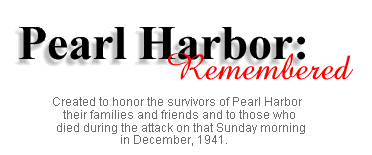
Because atmospheric static blacks out communications
with Hawaii, Marshall's message goes via commercial telegraph.
(It will reach Short's headquarters at 1145 hours.
He will not see it until about 1500 hours.)
0740 hours Planes of the first wave
take off from the Japanese carriers—49 high-altitude bombers, 51 dive-bombers,
40 torpedo planes, 43 fighters. They fly through
clouds, wondering if Pearl Harbor will be visible.
Then, as they near Oahu, the attack commander
hears a Honolulu weather report: "clouds mostly over the mountains.
Visibility good." The clouds break. The fliers
see "a long white line of coast"—Oahu's Kakuku Point.
0749 hours Air-attack commander Mitsuo
Fuchida, looking down on Pearl Harbor, sees no aircraft carriers, which
the
Japanese hoped to destroy and thus thwart U.S.
retaliation. He orders his telegraph operator to tap out to, to, to: attack.
Then other taps: to ra, to ra, to ra: attack,
surprise achieved.
Though not meant to have a double meaning, to
ra is read by some Japanese pilots as tora—tiger. And according to a Japanese
saying, "A tiger goes out 1,000 ri [2,000 miles/3,218
kilometers] and returns without fail."

USS Arizona Memorial
0755 hours At the Command Center
on Ford Island, Comdr. Logan C. Ramsey looks out a window to see a low-flying
plane.
A reckless U.S. pilot, he thinks. Then he sees
"something black fall out of that plane" and realizes it's a bomb.
Ramsey runs to a radio room and orders the telegraph
operators to send out an uncoded message to every ship and base:
AIR RAID ON PEARL HARBOR X THIS IS NOT DRILL
The coordinated attack begins as dive-bombers
strike the Army Air Forces' Wheeler Field, north of Pearl Harbor, and Hickam
Field,
near Ford Island's Battleship Row. The Japanese,
wanting control of the air, hope to destroy American warplanes on the ground.
Most U.S. planes have been parked wingtip-to-wingtip in neat rows to make it easy to guard them against sabotage. Most are destroyed.
0800 hours As part of a U.S. plan
to bolster the Pacific forces, 12 B-17 Flying Fortresses have been ordered
to the Philippines.
The first stop is Oahu. Unaware that Japan is
attacking Oahu, they prepare to land.
Because they are unarmed—to save weight—the B-17s
can only dodge Japanese fighters and U.S. antiaircraft gunfire.
Most manage to land intact-one touching down
on a golf course.
0810 hours An armor-piercing bomb,
dropped by a high-altitude bomber, pierces the forward deck of the Arizona,
setting off
more than a million pounds (450,000 kilograms)
of gunpowder, creating a huge fireball, and killing 1,177 men.
A sailor on the torpedoed battleship Nevada sees
the Arizona "jump at least 15 or 20 feet [5 or 6 meters] upward in the
water
and sort of break in two." In nine minutes the
Arizona is on the bottom.
0817 hours Through the flames and smoke, the destroyer Helm speeds to the open sea.
As the Helm leaves the channel, a lookout spots
a Japanese sub snagged on a reef. The Helm "turned hard right toward enemy
submarine," shoots—and misses. The two-person
sub breaks free and submerges. But it snags again. Trying to escape the
foundering sub,
one crewman drowns. The other is washed ashore—and
becomes the United States' first World War II prisoner of war.
0839 hours As the destroyer Monaghan
tries to "get out of that damn harbor as fast as possible," a nearby U.S.
ship signals that it has
sighted a submarine. The Monaghan heads for the
sub at top speed, hits it with gunfire, then rams it and drops depth charges.
The charges are so close that when they explode,
the blasts lift the Monaghan out of the water but do not damage her.
USS Arizona -- "that terrible day
The sinking midget submarine has managed to fire a torpedo. But it does not hit anything.
0850 hours The Nevada gets her steam
up in 45 minutes and, with antiaircraft guns blazing, heads for the open
sea.
A sailor sees her U.S. flag flying in the smoke
and thinks of the words of "The Star-Spangled Banner."
Japanese planes of the second wave bomb her, hoping
that by sinking her in the narrow channel she will bottle up the fleet.
Rather than risk that, she deliberately grounds
herself off Hospital Point.
0854 hours The second wave—35 fighters,
78 dive-bombers, and 54 high-altitude bombers—meets heavy antiaircraft
fire.
Bombers attack the navy yard dry dock and hit
the battleship Pennsylvania. Another bomber hits oil tanks between the
destroyers Cassin
and Downes. Onboard ammunition explodes, and
the Cassin rolls off her blocks and into the Downes.
Bombs hit the light cruiser Raleigh, which had been torpedoed in the first wave. Crewmen jettison gear to keep her from capsizing.
0930 hours A bomb blows off the bow
of the destroyer Shaw; pieces of the ship rain down half a mile (.8 kilometer)
away.
A photo of the spectacular explosion becomes
one of the best known images of December 7, 1941. Repair workers are on
the job
immediately. The Shaw eventually gets a new bow
and is back in action by July 1942.
Except for the Arizona, Utah, and Oklahoma, every ship sunk or damaged on December 7 will sail again.
1000 hours Japanese fighters do not
have homing devices or radar. They rendezvous with bombers
off Oahu and follow them back to the carriers.
Of the 29 Japanese planes lost, antiaircraft guns
probably shot down 15.
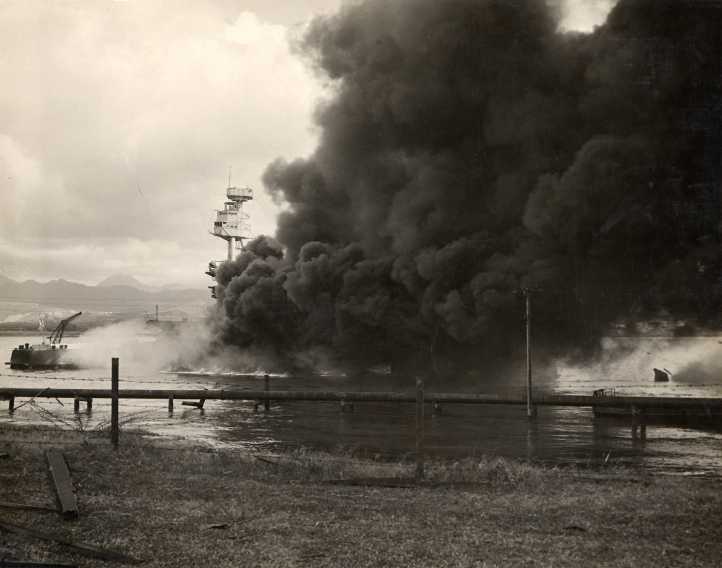
Exultant Japanese pilots urge a third strike.
If the gasoline tanks at Pearl Harbor are hit, they reason, the Pacific
Fleet will be out of action for weeks.
But superiors, saying the attack has been successful,
rule out a third strike. One reason: the whereabouts of the U.S. carriers
is still unknown.
1030 hours From the ships and airfields
come the wounded—some horribly burned, others riddled by bullets and shrapnel.
At some hospitals casualties are laid out on
lawns. Medics convert barracks, dining halls, and schools into temporary
hospitals.
For many severely wounded and dying men, all nurses
can do is give them morphine. They then put a lipstick M on their foreheads
to indicate the painkilling drug. Trucks become
ambulances and hearses. The death toll eventually reaches 2,390.
1300 hours The Pearl Harbor strike
force turns for home.
In the 44 months of war that will follow, the
U.S. Navy will sink every one of the Japanese aircraft carriers, battleships,
and cruisers
in this strike force. And when Japan signs the
surrender document on September 2, 1945, among the U.S. warships in
Tokyo Bay will be a victim of the attack, the
U.S.S. West Virginia.
1220 hours A heavily guarded black
limousine pulled up to the south entrance of the U.S. Capitol. President
Franklin D. Roosevelt
got out of the car and entered the Capitol, assisted
by his son Captain James Roosevelt, who wore the uniform of the U.S. Marines.
The chamber of the House of Representatives was
jammed with members of both houses of Congress, the
U.S. Supreme Court, official guests, and onlookers
in the galleries.
1229 hours The President, still on
his son's arm, entered the Chamber of the House, was introduced briefly
by Speaker
Sam Rayburn, and received a thunderous ovation.
For the past nine years, Republicans had shown little enthusiasm toward
the
President when he addressed a Joint Session of
Congress. This time, the Republicans joined in, signifying the nation's
sudden unity.
Solemnly, he began his speech requesting a declaration
of war: "Yesterday, December 7, 1941—a date which will live in infamy—
the United States of America was suddenly and
deliberately attacked by naval and air forces of the Empire of Japan."
1300 hours The Senate unanimously
adopted a resolution declaring war on Japan. At 1:10 p.m. the House voted
for war, 388 to 1.
The single dissenting vote was cast by Representative
Jeannette Rankin of Montana, who had also voted against a declaration of
war in 1917.
© 2001 National Geographic Society. All rights
reserved.
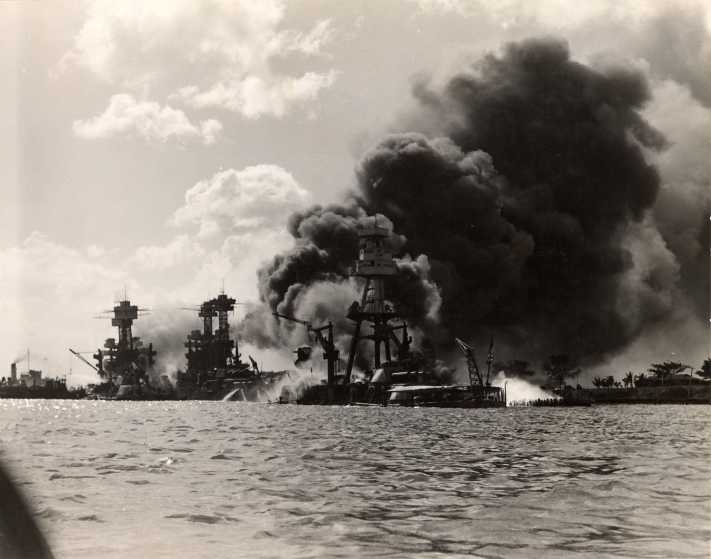
California Battleship 44 1919 21.0 knots Battleship
Row; forward of the Maryland and Oklahoma 2,200 2 torpedo hits, 0800-0810
hours; 1 bomb hit
Maryland Battleship 46 1920 21.0 knots Battleship Row; tied to the Oklahoma 2,100 2 bomb hits
Oklahoma Battleship 37 1914 20.5 knots Battleship Row; tied to the Maryland 1,301 5 torpedo hits; ship capsized; 429 men dead; 32 survivors cut out of hull in following days
Tennessee Battleship 43 1919 21.0 knots Battleship Row; inboard of the West Virginia 2,200 2 bomb hits
West Virginia Battleship 48 1921 21.0 knots Battleship Row; outboard of the Tennessee 2,350 6 torpedo hits; 2 bomb hits; half sunk
Arizona Battleship 39 1915 21.0 knots Battleship Row; tied to the Vestal forward of the Nevada 1,500 1 torpedo hit, 0805 hours; 8 bomb hits, 0810 hours; half sunk
Pennsylvania Battleship 38 1915 21.0 knots Dry dock; behind the destroyers Cassin and Downes 1,301 2 bomb hits, 0900-0910 hours
Nevada Battleship 36 1914 21.0 knots Battleship Row; tied to the Vestal, which was forward of the Nevada 1,500 1 torpedo hit; 6 bomb hits; beached on Hospital Point
Utah
Battleship 31 1911 20.0 knots
West side of Ford Island 1,001 2 torpedo hits; capsized to
port
Helena
Light Cruiser 50 1938 32.5 knots
Ten Ten Pier; inboard of the Oglala 1,700 1 torpedo hit
Cassin
Destroyer 372 1933 36.5 knots
Dry dock; next to the Downes 172 1 bomb hit, 0906 hours
Downes Destroyer 375 1933 36.5 knots Dry dock; next to the Cassin 172 2 bomb hits, 0906 hours
Shaw
Destroyer 373 1935 36.5 knots
Floating dry dock; west of the Pennsylvania and Ten Ten Pier 172
3 bomb hits, 0902 hours; badly damaged
Oglala
Minelayer 4 1917 20.0 knots
Ten Ten Pier; across from Battleship Row outboard of the Helena 300
1 torpedo hit, 0930 hours; capsized to port
Argonne
Flagship 31 1921 15.5 knots
Naval Yard dock; southeast of Battleship Row 85 No damage
Vestal
Repair Ship 4 1909 16.0 knots
Battleship Row; tied to the Arizona 466 2 bomb hits; beached
on Aiea Sands, 0945 hours
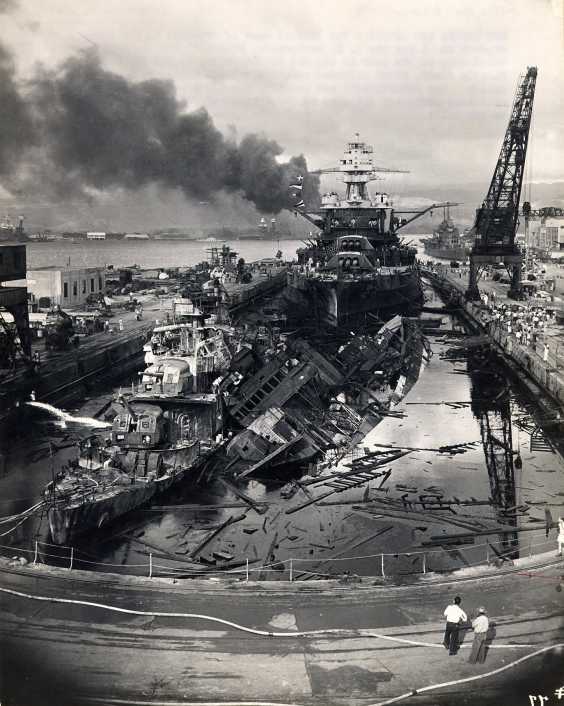
Akagi Red Castle 1927 31 knots 2,000
Kaga Increased Joy 1920 28.5 knots 27 Zeros, 27 Vals, 27 Kates 2,016
Shokaku Happy Crane 1939 34.5 knots 18 Zeros, 27 Vals, 27 Kates 1,660
Zuikaku Lucky Crane 1939 34.5 knots 18 Zeros, 27 Vals, 27 Kates 1,600
Hiryu Flying Dragon 1939 34.5 knots 24 Zeros, 18 Vals, 18 Kates 1,100
Soryu Green Dragon 1937 34.5 knots 27 Zeros,18 Vals, 18 Kates 1,100
Aichi 3A2,
Val Type 99 281 mph
(450 kph) 874 miles (1407 km) (1)
250-kg (551-lb) bomb under fusilage
(1) 60-kg (132-lb) bomb under each wing
Two back to back Carrier-borne, single-engine dive bomber
Mitsubishi A6M2 Zeke or Zero
Model 11 340 mph
(544 kph) 1,160 miles
(1867 km) (1) 60-kg (132-lb) bomb under
each wing One Carrier-borne fighter
Nakajima B5N2
Kate Type 97,
Model 12 225 mph
(360 kph) 683 miles
(1093 km) (1) 18-in (28-cm) torpedo
or (1) 500-kg (1100-lb) bomb Two to three
Single-engine torpedo bomber
Akagi, 1st Attack Unit 15 Kates 800-kg (1760-lb) armor-piercing bomb U.S.S. Maryland, U.S.S. Tennessee, or U.S.S. West Virginia
Kaga, 2nd Attack Unit 14 Kates 800-kg (1760-lb) armor-piercing bomb U.S.S. Arizona/U.S.S. Vestal, U.S.S. Tennessee, or U.S.S. West Virginia
Soryu, 3rd Attack Unit 10 Kates 800-kg (1760-lb) armor-piercing bomb U.S.S. Nevada, U.S.S. Tennessee, or U.S.S. West Virginia
Hiryu, 4th Attack Unit 10 Kates 800-kg (1760-lb) armor-piercing bomb U.S.S. Arizona, U.S.S. California
Akagi, 1st Torpedo Attack Unit 12 Kates Mk 91 aerial torpedo U.S.S. West Virginia, U.S.S. Oklahoma, or U.S.S. California
Kaga, 2nd Torpedo Attack Unit 12 Kates Mk 91 aerial torpedo U.S.S. West Virginia, U.S.S. Oklahoma, or U.S.S. Nevada
Soryu, 3rd Torpedo Attack Unit 8 Kates Mk 91 aerial torpedo U.S.S. Utah, U.S.S. Helena, U.S.S. California, or U.S.S. Raleigh
Hiryu, 4th Torpedo Attack Unit 8 Kates Mk 91 aerial torpedo U.S.S. West Virginia, U.S.S. Oklahoma, or U.S.S. Helena
Shokaku, 15th Attack Unit 26 Vals 250-kg (550-lb) general-purpose dive-bomb Hickam Field
Zuikaku, 16th Attack Unit 25 Vals
250-kg (550-lb) general-purpose dive-bomb Wheeler Field
Akagi, 1st Fighter Combat Unit 9 Zeros 20-mm (.79-in) cannon Hickam Field, Ewa Air Control, and grounded aircraft at Ford Island
Kaga, 2nd Fighter Combat Unit 9 Zeros 20-mm (.79-in) cannon Hickam Field, Ford Island Air Control, and grounded aircraft at Ford Island
Soryu, 3rd Fighter Combat Unit 8 Zeros 20-mm (.79-in) cannon Wheeler Field, Ewa Air Control, and grounded aircraft at Barbers Point
Hiryu, 4th Fighter Combat Unit 6 Zeros 20-mm (.79-in) cannon Wheeler Field, Ewa Air Control, and grounded aircraft at Barbers Point
Shokaku, 5th Fighter Combat Unit 6 Zeros 20-mm (.79-in) cannon Naval Air Station Kaneohe, Bellows Field Air Control, and grounded aircraft at Kaneohe
Zuikaku, 6th Fighter Combat Unit 5 Zeros 20-mm (.79-in) cannon Air control and grounded aircraft at Kaneohe
Shokaku, 5th Attack Unit 27 Kates
(1) 250-kg (551-lb) general-purpose bomb and (6) 60-kg (132-lb) regular
bombs bomb under fusilage
Kaneohe Naval Air Station
Zuikaku, 6th Attack Unit 27 Kates (1) 250-kg (551-lb) general-purpose bomb and (6) 60-kg (132-lb) regular bombs Hickam Field
Akagi, 13th Attack Unit 18 Vals 250-kg (551-lb) general purpose dive-bomb Ford Island NW, U.S.S. Neosho, U.S.S. Shaw, and U.S.S. Nevada
Zuikaku, 14th Attack Unit 17 Vals 250-kg (551-lb) general purpose dive-bomb Navy Yard, U.S.S. California, and U.S.S. Maryland
Soryu, 11th Attack Unit 17 Vals 250-kg (551-lb) general purpose dive-bomb Navy Yard, U.S.S. California, and U.S.S. Raleigh
Kaga, 12th Attack Unit 26 Vals 250-kg (551-lb) general purpose dive-bomb U.S.S. Nevada, U.S.S. Maryland, and U.S.S. West Virginia
Akagi, 1st Fighter Combat Unit 9 Zeros 20-mm (.79-in) cannon Hickam Field
Kaga, 2nd Fighter Combat Unit 9 Zeros 20-mm (.79-in) cannon Pearl Harbor
Soryu, 3rd Fighter Combat Unit 9 Zeros 20-mm (.79-in) cannon NAS Kaneohe
Air
Raid Pearl Harbor This Is No Drill !!!
© 2001 National Geographic Society. All rights
reserved.
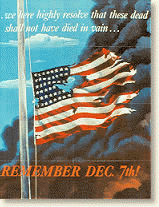
 |
 |
Sites Created
By "Jeff Doc Dentice"
CLICK
ON THE LINKS BELOW
|
|
|
|
|
|
|
|
|
|
|
|
|
|
|
|
|
|
|
|
|
|
|
|
|
|
|
|
|
|
|
|
|